Construction of Harcourt Road
After the end of WW2, the military and naval premises were repaired from war damages and used further on. Mainly on Hong Kong Island, these areas were situated right in the centre of the developing city. Any expansion to the east was impeded by these areas, mainly in the aspect of traffic (i.e. motor vehicles).
In March 1958, an agreement was reached between the Military and the HK Government to take over Murray Barracks, Murray Parade Ground and the Detention Barracks. (OFFICIAL REPORT OF PROCEEDINGS. Meeting of 6th March, 1958, p.45).
This was an important achievement for the further development of the city, new areas were ready for sale and construction of buildings. This didn’t help with the traffic problem. All of the traffic between the central district and Wanchai had to go through Queen’s Road East (Queensway). Not a wide road, and it had to be shared with the trams, a time consuming adventure during rush hours.
The general situation during the 1950’s can be seen on this photo from mid to end of the 1950’s.
On this photo Queen’s Road East/Queensway runs in front of the banks on the left, then around the cricket ground, turning right passing the Naval Dockyard buildings, then left again along Wellington Barracks to make a right turn at the junction of Arsenal Street and Hennessy Road.
In the mid-1950’s, it turned out that the Royal Navy had to be restructured. This included ships, crews, and naval facilities like docks. This was an excellent opportunity to start negotiations between the Admiralty and the HK Government to hand over premises including docks. Hand over meant sale for £7,000,000 sterling (see the HONG KONG LEGISLATIVE COUNCIL REPORT from 7. October, 1959 in a separate comment below)! After long negotiations, an agreement was reached in October, 1959 to start the hand over on November 30th, 1959 and to finish on January 1st, 1962 latest.
To overcome the traffic limitations on Queen’s Road East, a new road was needed which would run across the old Naval Dockyard. This new road would start at Connaught Road (junction with Murray Road) and end at Gloucester Road (junction with Arsenal Street).
The following map shows the “New Road Reserve”. It’s from the OFFICIAL REPORT OF PROCEEDINGS. Meeting of 7th October, 1959. Unfortunately, the map is shown only for the western part, so the eastern one is added from the 1957 Gwulo map (including a hand-drawn estimated road course).
To build this road, reclamation work was necessary. In the western part, the Dry Dock needed to be filled, in the eastern part the same had to be done for the Boat Pool/Camber. In front of Wanchai Police Headquarters a further small reclamation was necessary to widen the existing Gloucester Road. The necessity can be seen from this photo (showing Gloucester Road with Caine House built at the waterfront):
The next photo shows the reclamation work near the Boat Pool/Caine house (although attributed to 1968. my estimate is late 1960)
No detailed information is available for the start of the works, but quite likely in early 1960. The next photo from (quite likely early 1960) shows the demolition work of the dockyard workshops and houses at the tidal basin as well as (rock) filling of the dry dock while the Quarters (including Nissen huts) and Stores are still standing.
The next photo from end of 1960/early 1961 shows the construction of the road. The reclamation of a part of the Boal Pool has been finished, the same applies to Gloucester Road behind the Wanchai Police Headquarters. The new wall around the area that the Admiralty will still use has been built already.
The connection of the new road to Connaught Road can be seen here:
Looks almost finished, but the new road still not accessible.
The construction must have been done “high-speed” as the new road was opened in 1961 (Hong Kong Annual Report 1961). Wikipedia reports that on April, 7th, the road was named after Admiral Cecil Harcourt (1892-1959), the head of a provisional military government in Hong Kong from September 1945 to April 1946. This possibly was the day of the opening for motor vehicles.
The finished road is on the next two photos from 1962 and about 1962-64.
In 1966, the Harcourt Road Flyover was opened to connect Harcourt Road with Cotton Tree Drive.
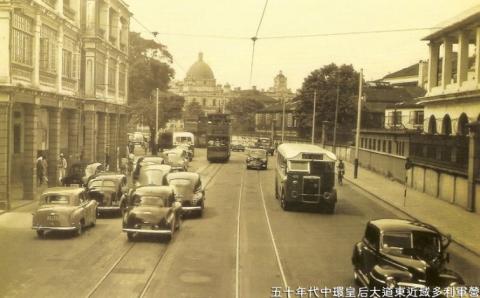
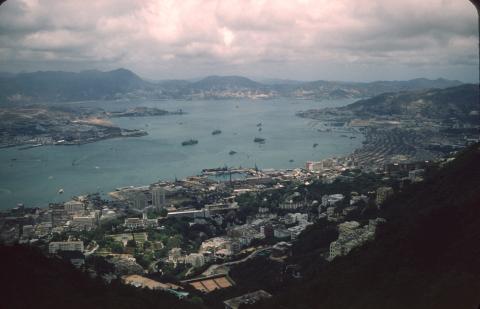
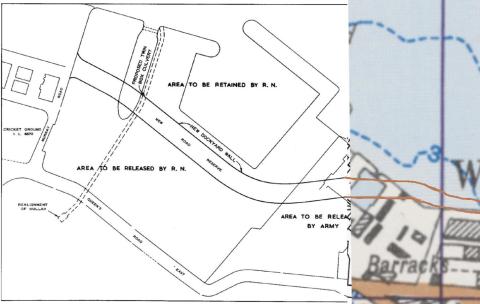
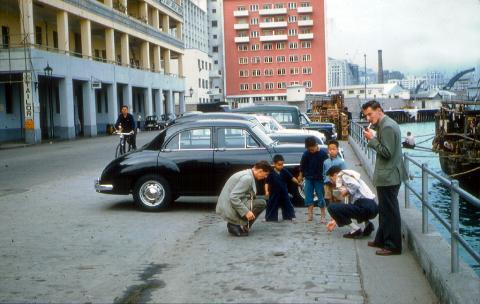
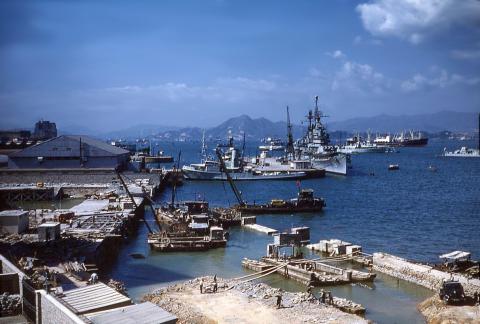
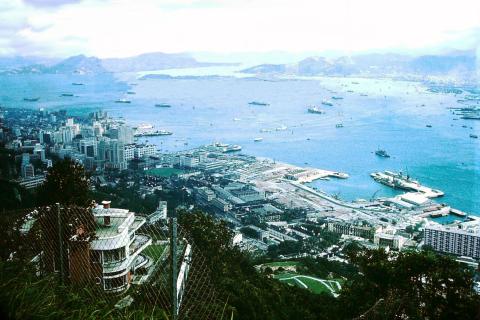
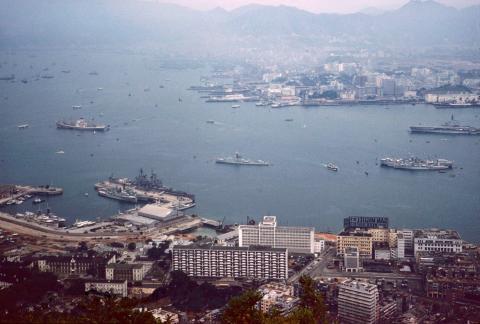

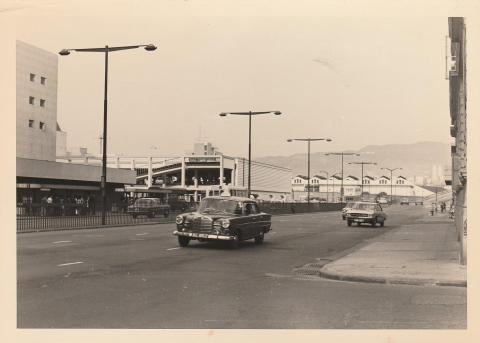
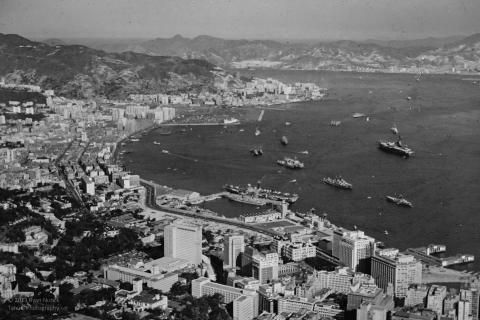
TERMS OF AN AGREEMENT BETWEEN THE GOVERNMENT OF HONG KONG AND TH
Excerpt from the report of the HONG KONG LEGISLATIVE COUNCIL (1959)
TERMS OF AN AGREEMENT BETWEEN
THE GOVERNMENT OF HONG KONG AND THE ADMIRALTY.
THE FINANCIAL SECRETARY moved the following resolution: —
Resolved that the Terms of an Agreement between the Government of Hong Kong and the Admiralty as shown in the Schedule be approved.
SCHEDULE.
1. The Admiralty will surrender to and hand over to the Government of Hong Kong on or before the 1st day of October, 1959 all that area known as Kowloon Naval Dockyard together with all piers, wharves, anchorage and appurtenances thereon to belong.
2. The Admiralty will hand over to the Government of Hong Kong by stages after the 30th November, 1959 that part of the Hong Kong Naval Dockyard coloured yellow on the annexed plan, such handover to be completed on or before the 1st January, 1962.
3. The Government of Hong Kong will pay to the Admiralty the sum of £7,000,000 sterling by the following instalments: —
(a) a first instalment of £1,000,000 on the 1st day of July, 1960; and
(b) twenty-four quarterly instalments of £250,000 each, the first of such instalments to be paid on the 1st day of July, 1961.
4. The Government of Hong Kong will reimburse to the Admiralty one half of the cost of walling up the entrance to the dry dock known as No. 1 Dock.
5. The Government of Hong Kong will provide at its own expense a boundary wall enclosing that part of the Hong Kong Naval Dockyard which is to be retained by the Admiralty as coloured blue on the annexed plan.
He said: Sir, the schedule which is recommended for approval by this Council sets forth the main points of an agreement concluded between this Government and the Admiralty, under which this Colony will get back considerable areas of the lands now occupied by the Navy, and with your permission, Sir, I shall give a brief explanation of the background.
The problem of military and naval lands in Hong Kong has been a thorny one ever since the foundation of the Colony. I do not propose to waste time by going into past history, but those interested may find it set forth in Endacott's "History of Hong Kong". Suffice it to say that the naval and military lands in the centre of the city were recognized as a serious problem as far back as 1875, when the Surveyor General, the Director of Public Works of those days, Mr. J. M. Price, wrote that the settlement—it was not then a city at that time—was "strangled at its waist" by these lands; a curious example of the mixed metaphor. Since then the problem has become progressively worse, and anybody who now has to travel between the central district and Wanchai during the rush hours does not need to be told of its gravity.
The possibility of solving this problem presented itself with the Admiralty decision to run down the Naval Dockyard, and I have the Governor's authority to quote him as saying that he was satisfied we must make every effort to solve it, because this opportunity to eliminate the bottleneck between the central and eastern parts of the city might never recur.
At the beginning of the discussions, the Admiralty indicated that they proposed to retain a part of the island area as a naval base, but that the remainder of the island area, and the whole of the Kowloon dockyard, could be given up. We showed them our plans with the roadline as indicated on the plan which is before honourable Members.
(map removed – see above)
This roadline, giving direct through access from Connaught Road to Gloucester Road, was recommended by the Public Works Department as providing the best solution to our traffic problem, and was agreed by Dr. Charlesworth. The Admiralty agreed to concentrate all their remaining activities to the north of this roadline, within the area coloured blue, and to release the area coloured yellow.
The negotiations then entered a more difficult stage. The Admiralty declined to entertain our proposition that they should hand back to us without any consideration lands for which they had no further use. On the contrary, they expected payment of the full market value. The question of what might be the full market value was not made any easier by considerations of title. Although the Admiralty title to certain areas was open to argument, it is very possible that they were entitled to assign or sell other areas as they wished. One such area of over 180,000 square feet, for example, has a long frontage on Queen's Road, and splits the whole naval area in two.
Agreement on title, and agreement on valuations, proved unattainable, and negotiations then proceeded on the basis of a package deal. I will not weary honourable Members by going into detail; the final result is summarized in the paper now before them. The consideration is £7,000,000, but payment is spread over seven years, without interest. We therefore have to pay a million pounds a year for seven years; the burden, although heavy, is one that the Colony's finances can, I feel, stand without undue strain. In addition, we meet the cost of a new wall round the much reduced area which the Admiralty will retain, and we meet half the cost of walling up the entrance to the drydock, which will be filled in. The cost of the wall is estimated at $210,000, and half the cost of walling up the drydock is estimated at $112,000. We agreed to this latter for the sake of getting on with the job quickly, because, as can be seen from the plan, the drydock must be filled in as a first step. Otherwise the new naval base will be split in two, and in any event the new road will go across it.
The whole of the Kowloon Naval Yard was in fact handed over to us on the 1st October, and part of it is now being used by the Stores Department. The whole of the Hong Kong area will be handed over before the end of 1961, although before then we expect to gain possession of parts of the area as they are vacated.
So much for the naval lands negotiations. They were difficult because there is no established and recognized procedure for dealing with naval land as there is with military land. We were anxious to get back these lands; the Admiralty for its part naturally wished to get the best possible terms. At one stage, indeed, the differences between us were so wide that negotiations were suspended. But finally we compromised; we made, as I have said, this package deal, which ignores questions of title, and provides for payment to the Admiralty of a sum substantially less than originally asked. It does not in any way constitute a precedent for any future negotiations that may take place on naval lands.
Now the whole purpose of these negotiations was to eliminate this “stranglehold round our waist”. We had reached agreement with the Admiralty for the surrender of their land, but this agreement was useless for our purpose unless we could also obtain the land to the east of the naval area which is coloured green on the plan before honourable Members. This area is War Department land and is known as War Department Lot No. 5. What is known as Wellington Barracks on this lot is occupied by the Navy as H.M.S. Tamar, but, as I have said, the area is still War Department land. We therefore had to make the agreement with the Admiralty conditional on agreement being reached with the War Department for surrender of this land. The War Department, prompted by His Excellency the Commander British Forces, whose personal help and support throughout I should like to acknowledge, agreed to negotiation, and I am glad to say that agreement has been reached for the surrender of this lot also in accordance with the usual Military Lands procedure. The agreement is in terms somewhat similar to that reached on Murray Barracks and Murray Parade Ground. It provides that this Government shall credit the War Department with the sum of $24 millions to be made available for Army works services in the Colony, and it further provides that this credit may not be drawn upon at a rate greater than $4,800,000 a year commencing in the financial year 1961/62. This area need not be handed over before the end of 1962 for reasons which I will give in a moment, but the Army has agreed to surrender the roadline on six months' notice being given, provided such notice is not given before the 1st January, 1960. I may add to that, that His Excellency the Commander British Forces has given us his assurance that, if we are ready to proceed with the road at a date before the 1st July, 1960, he will use his utmost endeavours to clear the line for us and allow us to go ahead.
The delays in handing over to us the various areas are necessitated by reprovisioning. Although the Dockyard is being run down, quite a considerable naval establishment will remain here, and it must all be reprovisioned within the restricted area which the Admiralty will retain. Accordingly time must be allowed for this reprovisioning. Particularly is this the case with War Department Lot No. 5 or H.M.S. Tamar. The Admiralty programme leaves H.M.S. Tamar to the last, and it is because of this that the agreement provides that the surrender of the green area need not be before the end of 1962. This perhaps is of no great moment, in view of the undertaking that the roadline will be surrendered at six months' notice.
I think Sir, that honourable Members, and the public generally, will agree that the time has come when it is essential that the bottleneck between the central and eastern parts of the city must be eliminated, and I should expect therefore that the greatest interest will be shown in the proposals for the road. The road will, as I have said, run through from Connaught Road Central to Gloucester Road and it will be necessary for the boat pool shown in the Army lot to be reclaimed, and for a further small reclamation to be made in front of Police Headquarters. I am sure that my Honourable friend the Director of Public Works will be happy to answer any questions of detail about this new thoroughfare, but I understand that, provided the necessary funds are voted by this Council, he is ready to start on the job just as soon as the land is available.
It may be of interest if I mention that the area of that part of the Hong Kong naval yard which we shall acquire is 962,000 square feet. It is roughly equal in size to the central city area bounded by Pedder Street, Queen's Road Central, Jackson Road and Connaught Road Central. The area of the Kowloon Naval Yard is 680,000 square feet—that is, the formed areas only, excluding the basins. The area of War Department Lot No. 5 is 461,460 square feet, of which the boat pool to which I have referred measures 56,182 square feet.
It is still for decision what we shall do with these lands when we obtain possession of them, and Your Excellency has directed as a first step that development of both the Kowloon Naval Dockyard area, and the land on the Hong Kong side, should be referred to the Town Planning Board, which will take into consideration, not only the lands now being surrendered, but also Murray Barracks, and also the new reclamations which are to be made on the waterfront. This will doubtless take time. There is one proposal for the Kowloon area which is likely to be pressed. This is that a part of the area, with the basin, shall be taken over by the Marine Department for the maintenance and servicing of the government fleet. The Marine Department at present has an area known as the Yau Ma Tei slipway, which is far too small for present-day needs. If this proposal be approved, the area at Yau Ma Tei can be vacated and will be available for disposal.
I have, Sir, tried to the best of my ability to set forth as briefly as possible the terms of these agreements. The cost of getting back these lands is perhaps heavy in relation to the present-day value of the land that we are obtaining, even though payment is to be spread over seven years. But I suggest to honourable Members that it would be short-sighted to look at this payment as a payment for land alone. If we do not get these lands, then I think that without question we shall have to incur very heavy expenditure on road widening, or on fly-overs, to try to improve the traffic congestion at the foot of Garden Road and round the Cricket Ground. And the result would never be satisfactory. A
glance at the plan will show honourable Members that a large proportion of the traffic now passing the junction of Queen's Road, Murray Road and Garden Road is likely in the future to go along the new road. I think indeed it is fair to expect that all the traffic between the existing and future central reclamations, and the eastern district, will go along the new and, I trust, wide road through what is now the Naval Yard rather than round the corner of Queen's Road and Murray Road. The price we have to pay, considered as a price for land, may be high, but the deal should not, I think, be regarded as a purchase of land for development by a speculator. It is very much more than that. It breaks that "stranglehold round our waist" which has persisted for so long; it enables us to breathe.
I commend it to this Council for approval,
THE COLONIAL SECRETARY seconded.
MR. NGAN SHING KWAN: —I rise to speak on behalf of myself and all my unofficial colleagues.
The resolution before Council, if adopted, will mark the beginning of the end of a problem that has plagued Hong Kong for the greater part of a Century. For decades our predecessors on Council have advocated the removal of the Royal Naval Dockyard, and have roundly condemned the restriction it imposes on road communication between the heart of Victoria and the eastern part of the Island. At the same time the naval and military lands have impeded the natural expansion of the city towards the east.
Last year agreement was reached whereby the Murray Barracks area is to revert to Government. Since then the Dockyard has also become available for disposal, and the Unofficial Members of Council are unanimous in their agreement that Government should not let slip this opportunity of acquiring land which has been a source of frustration for so many years. Unfortunately, as is apparent from the remarks of the Honourable Financial Secretary, the decision to close the Dockyard did not in itself provide an answer to the problem, as might reasonably have been expected. On the contrary it led to complicated and protracted negotiations with the Admiralty which at one stage threatened to deprive the public of the use of these lands indefinitely. However, an agreement on the Admiralty's final minimum demands was eventually reached, to which the Unofficial Members reluctantly gave their approval, after satisfying themselves that the Government had made the best of a hard bargain.
With these remarks, Sir, and on behalf of the Unofficial Members, I support the resolution before Council.
The question was put and agreed to.